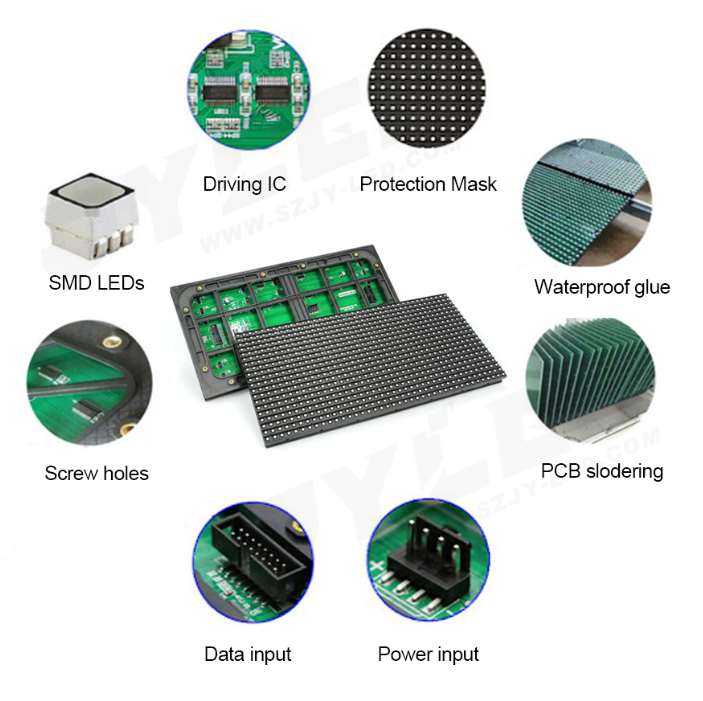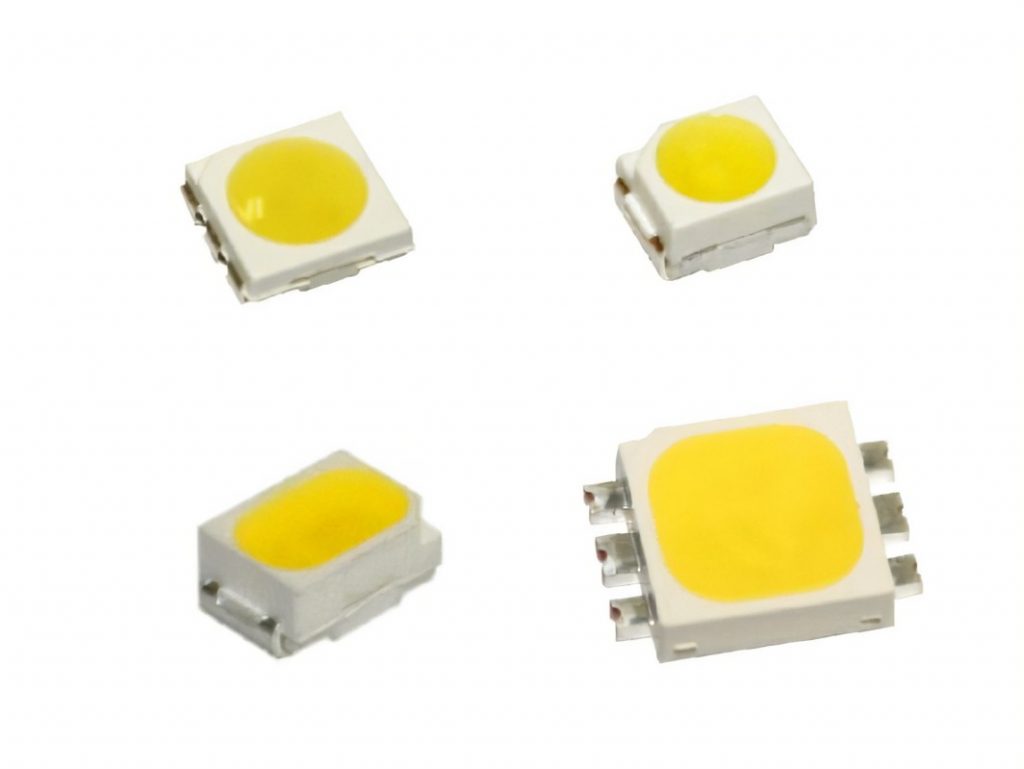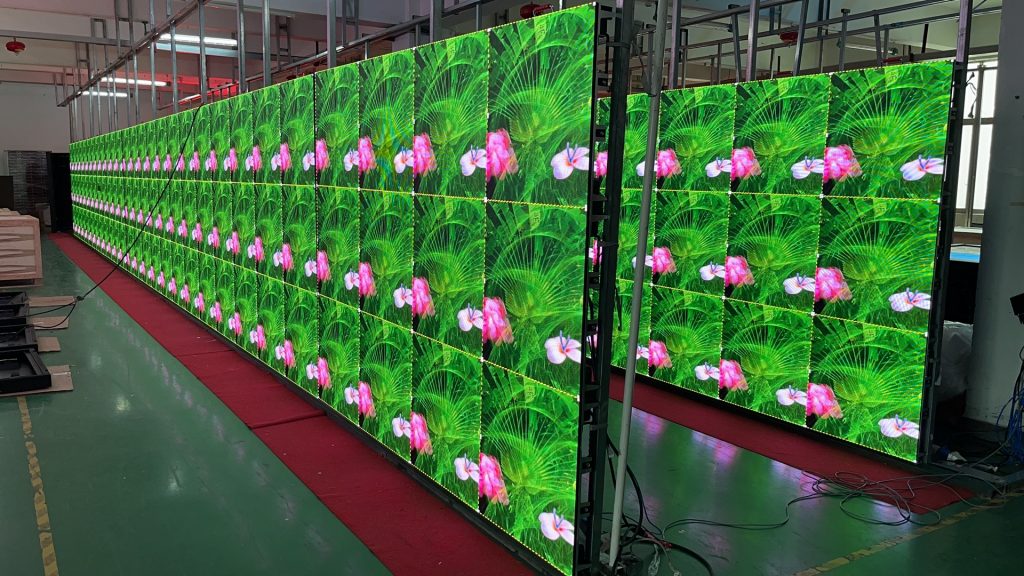P2 LED display screen is usually fixed on the wall and consists of the following parts: unit board, starting power supply, sending card, receiving card, internal connection power cable, signal cable, network cable, fixed frame, and wrapping material.
The technical parameters are mainly reflected on the unit board, and the device configuration on the unit board is the core value. The main components are: LED light-emitting chip, packaging technology, IC driver chip, PCB circuit board, module kit, mask, signal flat cable, power cable, plus power supply, control card, magnets, screws, etc. to form the entire display system.

The main technical parameters are: resolution, white balance brightness, power consumption, scanning method, viewing angle, refresh rate, grayscale/color, flatness, runaway rate, contrast, service life, and protection level.
The indoor LED display is customized according to the model and size of the user’s needs. The size and area are large and small, and there are many types and models, resulting in different screen resolutions, different power consumption, and different peripheral auxiliary equipment.
For example, a 3*2m size indoor P2.5 full-color screen with a resolution of about 1200*800 requires site wiring of 4 square millimeters of copper wire, and consumes about 3 kWh of electricity per hour; if a 3*2m size indoor P5 full-color screen is used , the resolution is about 600*400, the power consumption per hour of the 2.5 square millimeter copper wire is about 1.5 degrees per hour; other supporting hardware: 1 computer, 1 set of power amplifier, audio, ordinary network cable, etc.

After we understand the supporting materials, we also need to understand some evaluation methods of small-pitch LED displays, so that we can buy better quality LED displays.
A small-pitch LED display that is qualified and can stand the test must have undergone strict relevant tests before leaving the factory. Only in this way, after it is officially delivered to customers, can it ensure normal operation and good display effect for a long time, and reduce the failure rate.
So, what tests do you need to go through to know the quality of a small-pitch LED display? Let’s take a look.
Evaluation requirements for small-pitch LED displays
(1) Grayscale image test
①The test of grayscale and color level has always been an important index reference for DLP/plasma/LCD/LED and other large screens or spliced large screens, and is used to evaluate the grayscale transition capability of large screen splicing and the controller (if any), and Black and white conversion capabilities, etc. The more obvious the contrast, the stronger the ability of the display system to process the color picture.
The bidirectional grayscale signal is used to test at least 16 grayscale levels that the system should display. If each level can be distinguished, 3 points are awarded; if less than one level is distinguished, 1 point will be reduced, and the minimum score for this item is 0. When we use the computer, sometimes we also use grayscale to test whether the computer screen has bright spots, dark spots and dead spots.
②Comprehensive test of sharpness and gray scale. This scene is used to comprehensively test the performance of the entire system, such as line count, grayscale, and geometric distortion. Under 1080P (1920×1080), each gray level and line number should be clearly distinguishable, and the black and white purity of gray level can also be tested. 1 point is deducted for a questionable item; minimum 1 point.
③Gray-scale real picture. The more black and white levels are displayed, the better the grayscale processing capability of the system is. Minimum 2 points, maximum 5 points.
(2) Color picture test
①Comprehensive test of dark parts of color pictures. This scene is a night scene, focusing on the intensity changes of color light and shade and halo, and is used to test various performances of the system such as color, grayscale, and detail display. The light on the top of the boat on the left under the bridge, the top halo above the main tower and the bridge deck cables can be clearly distinguished, and 4 points are awarded. If there is a problem, 1 to 2 points will be deducted depending on the severity. If there is no problem in distinguishing light and dark changes in other details, add 1 point.

②Highlight detail test: The detail restoration ability test with bright white as the keynote. This scene is a high-brightness dining table and dresser. It mainly tests the restoration ability of the white part of the system under high light and the dynamic range of grayscale. The texture details of window curtains, cloth, brushes and other objects should be completely preserved. All items are met, 5 points. If there is any non-compliance, 0.5 points will be deducted for each item, and a maximum of 2 points can be deducted in total.
③Face detail clarity test. This scene is a close-up static picture of a girl and flowers, which reflects the fidelity of the large-screen splicing system to various details such as face skin color and spots, as well as the authenticity of the skin color. The total score is 5 points, and the facial details are not clear, and 0.5 points are deducted. If the color of the face is not pure, 1 point will be deducted.
④Color reproduction test. Mainly test the uniformity of color and the purity of white. It is very important to restore and display various ingredients and fruit colors in the kitchen, pure white crystals on the tray and the barrel of colored pencils, wood grain parts, grassland and clouds, etc. If the white color is not pure, 1 to 3 points will be deducted depending on the purity of the color cast. The full score is 5 points.
(3) Dynamic video test
The above two items are all static information tests. What tests the ability of the display screen is its dynamic test. Test the performance of its dynamic display mode through the following points.
①Play high-definition video material. Generally on a mobile phone or computer screen, we will judge the fineness of the screen by how many Hertz the refresh rate reaches. On the LED display, we can also check the motion trajectory of dynamic high-definition material. The output Hz of the display screen. The higher the output Hz, the finer the picture and the better the quality.
②Intermittent pause. Through intermittent pause, check the tearing sense of the picture, you can intuitively understand the playback ability of the LED display. The LED display with good quality can be paused and played anytime and anywhere without affecting the picture quality. The display effect of the poor quality of the display, the screen will appear tearing, poor picture quality and so on.